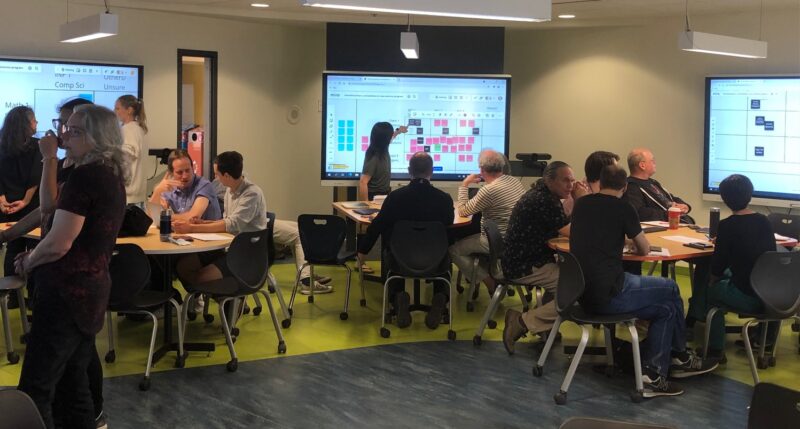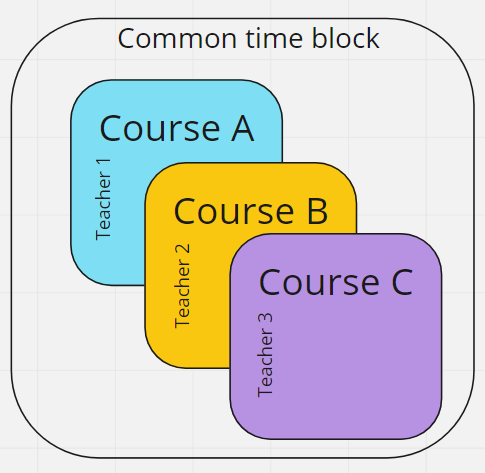Winter 2022 Learning Communities Recap

Brainstorming interdisciplinary connections in the new Science program, June 8
I. W22 Project Wrap: Interprofessional Education, Physics for Physiotherapy Technologies and The Temple: Religion and Classics
The final meeting of faculty working on W22 LC projects took place on May 30, with reports from all three teams on their accomplishments.
Physics for Physiotherapy: Maureen MacMahon (Physiotherapy Technologies), Chris Roderick (Physics)
As the P/P team noted in their April update, “Consultation among faculty members of the program made it clear that physics principles pertain not only to the few courses that are linked to specific physics competencies in the program matrix, but that they truly are foundational knowledge from day one of the program.” Embarking on this insight, Chris and Maureen advanced on several fronts over the rest of the winter. First, they worked on building a common view of the role of physics within the physiotherapy profession, which resulted in the development of a glossary of terms; a guide to physiotherapy for physics teachers; and a set of cases and illustrations that would express the physics of patient stability and position-dependent anatomical forces in learner-friendly terms. Second, through faculty discussions, class visits and on-site consultations in the DCHC, they identified several threshold concepts that would be central to learning activities and teaching texts in the new Physiotherapy program. Finally, drawing on the work above, they reviewed the curricular alignment for physics concepts through the three years of the Physiotherapy program, and mapped out how learning outcomes for the revised Physics for Physiotherapy course could be utilized in the Course Flow platform to coherently structure course units. To boot, they documented this work in a magisterial Miro board, ensuring that the program can easily access, apply and adapt their results – and confirming that physiotherapists and physicists are digital artists too!
Interprofessional Education: Sharon Clegg (Physiotherapy Technologies), Lucien Chiasson (Nursing), Tim Miller (IPE and Physiotherapy)
The IPE team presented their designs for two sessions of interprofessional learning activities that will bring together third-year students in Physiotherapy and Nursing. These activities focus on case-based explorations of key interprofessional “meta-competencies:” role clarification, team functioning and communication. An innovative feature of the activities is the participation of Professional Theatre students in role-playing simulations that introduce students to an intentional model for motivational change in patient behaviour. Finding a feasible time-block to run the two sessions posed a significant challenge for the team. However, a solution presented itself in the addition of Laura Shea (Sociology) to the project. Laura’s third-year Sociology class for Nursing, Sociology of Healthcare, turned out to be a perfect launch pad for these IPE sessions. The overarching objective? To help Physio and Nursing students grasp that when the quality of interprofessional collaboration is improved, accompanying gains will follow in the collective competence of professional care, and in subsequent patient outcomes.
The Temple: Introduction to Classics and Introduction to World Religions: Johanne Rabbat (Religion), Jiri Tucker (Classics)
This pairing of two introductory Social Science courses will employ a format we are calling “LC lite:” The courses are enrolled with different students, but are scheduled in a common time-block to permit intermittent team-teaching, integrative learning activities and shared field trips. For Jiri and Johanne, the first half of the winter was mostly occupied with addressing scheduling challenges. Finding a single, appropriate time-block for the integrated learning activities of their two courses proved difficult, but with help from Scheduling and Isabelle Carrier, Social Science Dean, they addressed not only the class time issue but also the logistics for two off-campus field trips. With scheduling challenges addressed, Jiri and Johanne immediately met new obstacles in finding a space that would be suitable for up to 80 students at once. Such spaces are few and in high demad at Dawson, and the question remains open. In the meantime, they worked on the development of a single Moodle site for the two courses, and on a set of six integrated learning activities (on and off campus) that the two classes would experience together, using the following themes and locations:
- Interpreting artifacts
- Understanding hierarchy and privilege
- Montreal Museum of Fine Arts: The South Asian Collection
- Trip to the Tan Bao Son Buddhist temple in Harrington, Qc.
- Performance by a traditional Hindu dancer in the Dawson Theatre
II. The “LC lite” Model: Certificates Workshop, May 27

LC Certificates Lead Pat Romano led a session on May 27 in the CoLab on the potential offered by common time blocks for teachers who would like to experiment with team-teaching, but are not ready for the all-in collaboration of the traditional paired-course format. The “lite” format allows the design of integrative activities by placing two or more courses in the same time block. Teachers can swap classes or bring their classes together in a single large space for guest lectures, symposia, or other special events. This is of particular interest to Certificates, which feature a common interdisciplinary theme that links participating teachers from many disciplines. The Temple LC, mentioned above, will employ this approach, linking Classics and Religion using courses that are already cross-listed for the Hellenic Studies Certificate. The session was attended by teachers from English, Humanities, Fine Arts, and Physics, among others. A similar session is planned for Fall 2022.
III. Interdisciplinary Connections in the New Science Program, June 8
LC Science Leads Annie-Hélène Samson and Jean-François Brière led a two-hour brainstorm session devoted to identifying possible points of disciplinary convergence and integration in the new Science program, slated for implementation in Fall 2023. The new ministerial Science competencies have been circulated but course frameworks have yet to be developed – an ideal moment, the LC leads believed, to consider how alignment and integration might be figured into the specific details. A program-wide mapping of Physics, Math, Biology, Computer Science and Chemistry affinities was launched and continue this fall.
IV. Survey on Learning Communities in Relation to the Graduate Profile Outcomes, F21 and W22
At the request of Catherine Lebel (OAD), LCs developed a survey to gather student views on how effectively LC courses address the outcomes of Dawson’s Graduate Profile, the core of the 2016-2021 Strategic Plan. The survey was completed by students in LC courses in F21 and W22 with a participation rate of 56% and 33% respectively, for a total of 240 respondents. For each of the nine outcomes, a majority of respondents agreed or strongly agreed that their LC courses successfully addressed the criteria. Sixty percent of all respondents stated that they were “more” or “much more” engaged and motivated to learn in LC classes in comparison with traditional stand-alone classes. Katherine McWhah and Kinga Brenning in the Quality Assurance and Planning Office provided valuable input and assistance towards the creation and completion of the survey.
V. LCs in the New Social Science Program
LCs have been a topic of consistent interest over the course of this year’s Social Science Program Committee work on the new Social Science program, especially in relation to the new multidisciplinary methods course, Introduction to Research. Thanks to the contributions of Social Science lead Lisa Steffen and OAD’s Monica Lopez, the potential for interdisciplinary pairs and clusters has been integral to ongoing conversations about course design and program implementation (which begins in 2022-23).
VI. Ongoing and New LCs
Established LCs continue to be supported in Science, Social Science and Certificates. New teachers and sections were added to the Physics/Calculus and Biology II/Organic Chemistry pairings in Science. Multiple pairs and clusters are now in advanced iterations in Certificates (e.g. Imaging Violence and Nonviolence; Nature Revisited) and Social Science (e.g. Race, Ethnicity Migration; Social Justice in Canada?). Multidisciplinary 365 Complementaries offered in updated forms included Gender Matters, Peace 365, SPACE’s Make Things that Matter, and Introduction to Neuroscience Research. LC Science lead Jean-François Brière continued the development of a faculty Sharepoint site for archiving LC course documents, with the aim of facilitating the onboarding of new teachers. New LCs this winter included the Decolonization and Indigenization 365 Complementary (DIS Certificate), led by two Indigenous co-teachers, Morgan Philips and Amanda Lickers alongside Jocelyn Parr (History); a Social Science IS/Geography pairing, “Social Movements in Montreal: The City as Classroom,” co-taught by Mark Beauchamp (History) and Sara Kendall (Geography); a DIS-themed Integrative Seminar titled “Social Justice Movements” taught by Ben Lander (History); and finally “Story Values,” a pairing of English and Humanities B-block courses for the SPACE certificate, led by Andrew Katz (English) and Robert Stephens (Humanities).
VII. Publications: Nature Revisited English-Physical Education LC
Ian MacKenzie (English) and Doug Smyth (Physical Education) co-authored a chapter for an upcoming Routledge collection Ecopedagogies: Practical Approaches to Experiential Learning. Their chapter, “Nature Revisited: Ecopedagogy in an English-Physical Education Learning Community,” introduces six guiding principles for the creation of interdisciplinary outdoor education LCs.



